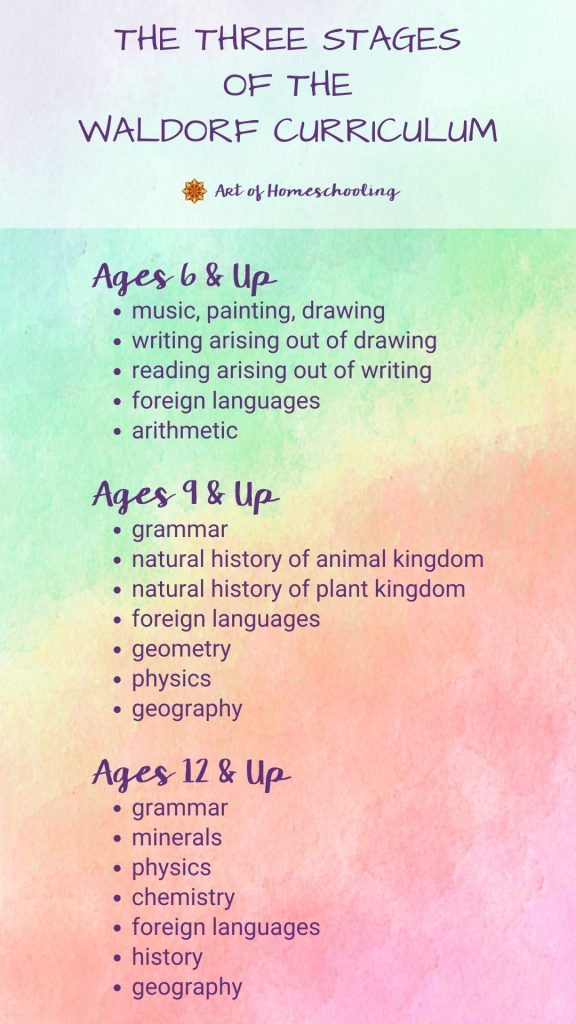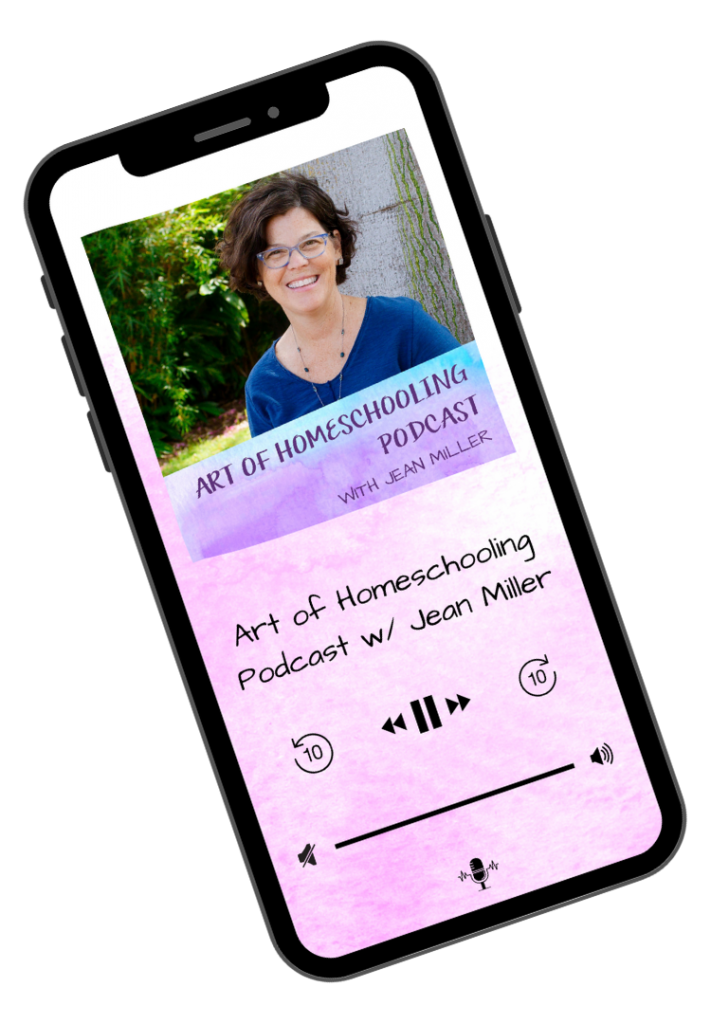Episode 103
In this episode of the Art of Homeschooling Podcast, I want to share with you a simple summary of what we teach our children at different stages of their schooling. Rather than looking at each grade specifically, I like to consider the three stages of the Waldorf curriculum.
This perspective comes from an enlightening lecture that Rudolf Steiner gave to the teachers in the very first Waldorf school back in the late summer of 1919, right before that first school opened.
Developmental Stages versus Grade by Grade Planning
In this lecture, which can now be found as “Lecture Ten” in the book Practical Advice to Teachers, Steiner outlines the three stages of the Waldorf curriculum: from ages 6-9, 9-12, and 12+.
This is super helpful whether you follow the Waldorf approach or not, because this idea helps us to shift from thinking about from a grade-by-grade perspective to an understanding of the develepmental stages and the 3 or 4 grades they each span. This is a unique way of looking at the subjects we teach.
As you may know, Steiner never wrote out a detailed curriculum. Many believe he intended to eventually, but he died five years after the first Waldorf school opened and those years were consumed with all of the challenges that come with opening a new school.

The Whole to the Parts
Steiner opens this particular lecture by describing the need to go from the simple to the complex, to build up the curriculum slowly. Helpful advice for those of us homeschooling!
“The curriculum will not at first contain everything, for we shall build up the way we view things by degrees.”
~Steiner
This is so much like the advice I share with homeschoolers all the time – to scale back until it’s working and then add from there.
We have to start simply and then gradually get more complex. Building up the curriculum slowly really helps us simplify our teaching but also encourages our children to engage more readily with the lessons. And it also fits with the Waldorf idea of moving from the whole to the parts.
This lecture details a critical piece of the Waldorf curriculum framework. And is a great starting point for homeschoolers because the three stages are not grade-specific but a sequence of subjects from about age six or seven through the elementary years and even on into high school. This adds a sense of fluidity to the curriculum and can help us feel more relaxed, thinking about the school years as being broken up into three longer, more fluid stages versus grade by grade.
“It will be good (speaking now of the ideal) to have less of a sharp differentiation between the classes within each stage than between the stages themselves.”
~Rudolf Steiner
Child Development
I also want to give a little background here into Steiner’s view of child development. Steiner observed that in the preschool and kindergarten years, children learn best through play. So he proposed that formal lessons begin in first grade, generally the year a child is 6 years old, turning 7.
Steiner describes the stages of child development as being from ages 0-7, 7-14, and then 14+. These correspond to the preschool/kindergarten years, the elementary years, and the high school years. The 3 stages of the curriculum that we’re talking about today all fall within the elementary and high school years.
This is because formal learning with the Waldorf approach doesn’t begin until around the age of age 7 or the year a child is turning 7. And so in this lecture, Steiner has divided the elementary and high school years into three stages of learning.
The Three Stages of the Waldorf Curriculum
Here are the Three Stages of the Waldorf Curriculum along with the topics and types of activities he suggests we focus on at each of these stages.
I. Ages 6-9
- the artistic realm is the starting point
- music, painting & drawing
- writing arising out of drawing, reading out of writing
- foreign languages (only learning to speak)
- arithmetic somewhat later
II. Ages 9-12
- developing self-awareness
- Grammar ~parts of speech, word families & word-inflections
- natural history of animal kingdom
- natural history of plant kingdom
- foreign languages
- geometry
- physics
- geography
III. Ages 12 & Up
- grammatical syntax (sentence structure)
- minerals (through geometric forms linking to physics)
- physics
- chemistry
- foreign languages
- history & geography
Steiner talks a lot about the economy of teaching – that we don’t have to spend hours and hours every single day in lessons. And in fact, that can truly exhaust a child. Rather, we want to review what we’ve learned so far, introduce new concepts through story, and then engage in hands-on artistic activities to help children retain the learning.
So with these 3 stages of the curriculum, Steiner points out that it is economical to teach in this way. And that we build from the bottom up, from those first subjects and then add from there. While really bringing as much hands-on learning as we can.
“We must bring our intellectual age back to the realm of the will…what the teacher speaks is not followed by reflection on what he has said or by a slow spoken answer, but by action.”
~Rudolf Steiner
The Waldorf-inspired Homeschool Approach
I find this really inspiring. Honestly, as homeschoolers, once we have more than one child, using a grade-by-grade curriculum can be overwhelming.
How much easier would it be to use this list of subjects and design lessons for all of our children together?
For example, doing geography or grammar all together with different activities geared toward the different ages of our children. Or studying the natural history of animals or plants while helping our kids in the earlier grades work on their writing and reading, and helping our kids in middle school begin to hone their research skills.
When I had a conversation about this lecture with a homeschooling friend, she reflected with this: To heal the culture by incorporating a more ancient slower time-table – to unite the intellect with feeling and will through practices like working with the memory through recitation and the idea of reading coming from writing…or embracing Steiner’s words ”binding the human being to the world versus abstracting the human being from the world” …this is giving me a lot to think about!
Weaving Together a Holistic Homeschool Curriculum
In reviewing all this, I also noticed once again Steiner’s similarity to Charlotte Mason with his emphasis on narrative retelling instead of formal composition up until high school. Steiner definitely thought that the ability to retell accurately and thoughtfully (versus completely imaginative creative writing, or teaching children a set paragraph structure or template for writing) was one of the most important goals for the scope of the entirety of the elementary years and the foundation upon which any fruitful composition instruction rests.
I’ve seen this over and over again with my own three children as well as with other homeschoolers who follow a Waldorf approach. First, children develop their ability to verbally summarize, to retell accurately, and then to write concise summaries. To me, having been a high school English teacher, this is really such an important foundational skill for higher education and learning in high school and beyond.
I also find it reassuring to realize that Steiner and his first Waldorf school had to factor in the constraints of reality just like we do. Steiner was a pragmatist. And his goal was to instruct his teachers in how to bring the learning alive in new ways ~ beyond the teacher-as-lecturer assumption that was prevalent in schools at the time just as it still is today. I find that these lectures from the Teacher’s Seminar can be more helpful and inspiring to us as homeschoolers than trying to model ourselves after a Waldorf classroom.
A Simple Place to Start
These three stages of the Waldorf curriculum can be a simpler starting point for our homeschooling than trying to cover each grade’s curriculum ~ especially if we have more than one child.
This outline is a progression, a sequence. This could also allow for us to envision how we might combine grades or at least overlap some subjects in a homeschool setting.
This approach is worth exploring further, particularly as it applies to Waldorf homeschooling. I encourage you to take this in and see how these ideas might help you be more fluid in your lesson planning and homeschooling going forward!
Want Help Simplifying?
I have a wonderful bundle that can help you! Check out Homeschool Simplicity 101 for guidance in bringing it all together. You’ll get the Homeschool Simplicity Handbook along with a video training on putting your planning together in a simple way even if you’re homeschooling multiple ages. Plus beautiful planning templates and my secret sauce, designing your minimum viable homeschooling day so you can feel confident and successful in your homeschool. 😉

Rate & Review the Podcast
If the Art of Homeschooling Podcast has inspired you, I’d LOVE it if you could rate and review the podcast on your favorite podcast player! Reviews can be left on Apple Podcasts (iTunes), Podcast Addict, or Stitcher.
Or simply pop on over to lovethepodcast.com/artofhomeschooling and choose where you want to leave your review.
And if you want to show your appreciation for the Art of Homeschooling Podcast, you can buy me a coffee!
Never Miss an Episode!


Check Out All the Episodes Here



